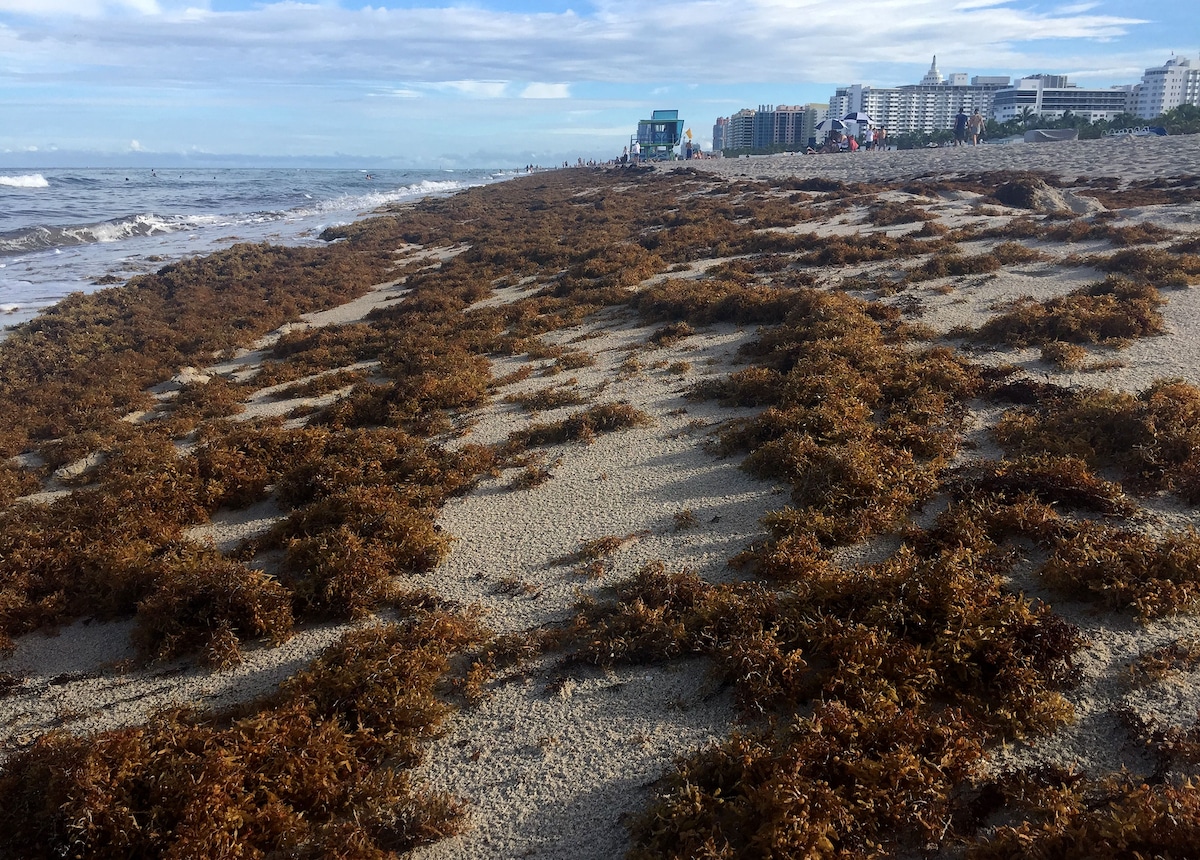Giant Seaweed Blob Twice the Width of the U.S. Starts to Arrive in Florida

 Why you can trust us
Why you can trust us
Founded in 2005 as an Ohio-based environmental newspaper, EcoWatch is a digital platform dedicated to publishing quality, science-based content on environmental issues, causes, and solutions.
Like something out of a classic sci-fi film, marine scientists are tracking a giant seaweed blob approaching Florida’s Gulf Coast. The 5,000-mile-wide swarm of seaweed — which scientists say could be the biggest in history — is so large it can be seen from space.
The colossal seaweed mat was caused by a huge sargassum seaweed bloom. Usually found east of the Gulf of Mexico in the Sargasso Sea, sometimes sargassum blooms can become gigantic and make their way to land, reported Newsweek.
“When too much sargassum piles up on the beaches, it can be harmful to the local environment, tourism, and artisanal fisheries, etc.,” sargassum researcher from the University of South Florida Mengqiu Wang previously told Newsweek.
As the blob floats through the sea, crabs, turtles and fish use it as a breeding ground, The New York Times reported.
But as the blob gets closer to shore it can block light from getting to sensitive corals and affect water and air quality, reported The Hill.
When it comes ashore on beaches in Florida and other locations along the Gulf of Mexico, it will emit toxic fumes as it begins to rot, scientists say, and could be a threat to human health, The New York Times reported.
Rotting seaweed releases hydrogen sulfide, causing respiratory issues, said research professor at Florida Atlantic University’s Harbor Branch Oceanographic Institute Brian LaPointe, as reported by NBC News.
“Following the big 2018 blooms, doctors in Martinique and Guadeloupe reported thousands of people going to clinics with breathing complications from the air that was coming off these rotting piles of sargassum,” LaPointe said.
The blob has already begun to come ashore in the Florida Keys and some places in Mexico, reported The New York Times.
“You can’t get in the water,” said travel YouTuber Leonard Shea in a recent video from Mexico’s Playa del Carmen, as The New York Times reported. “It’s not an enjoyable experience.”
The Gulf Coast of Florida has already been dealing with a recent episode of red tide, caused by an algae bloom that has killed fish and presented respiratory risks to humans.
With rising ocean temperatures due to climate change, marine environments are becoming more ideal environments for algae to grow.
Assistant research professor at the University of South Florida’s College of Marine Science Brian Barnes said the seaweed mass seems to be growing each year, with the biggest blobs occurring in 2018 and 2022, reported NBC News. Barnes said this year’s accumulation is getting close to the previous records.
“Historically, as far back as we have records, sargassum has been a part of the ecosystem, but the scale now is just so much bigger,” Barnes said, according to Newsweek. “What we would have thought was a major bloom five years ago is no longer even a blip.”
Scientists aren’t sure precisely how and why the great Atlantic Sargassum belt, as the tangle of seaweed is known, is growing, but it seems to correspond with the seasonal discharge of major rivers like the Amazon, Congo and Mississippi, The New York Times reported.
The phosphorus and nitrogen from the runoff feed the bloom, LaPointe said, as do nutrients produced by emissions from the burning of biomass and fossil fuels.
“These blooms are getting bigger and bigger and this year looks like it’s going to be the biggest year yet on record,” said Lapointe, as reported by The New York Times. “This is quite early to see this much, this soon. It just doesn’t bode well for a clean beach summer in 2023.”
Subscribe to get exclusive updates in our daily newsletter!
By signing up, you agree to the Terms of Use and Privacy Policy & to receive electronic communications from EcoWatch Media Group, which may include marketing promotions, advertisements and sponsored content.

 233k
233k  41k
41k  Subscribe
Subscribe 




